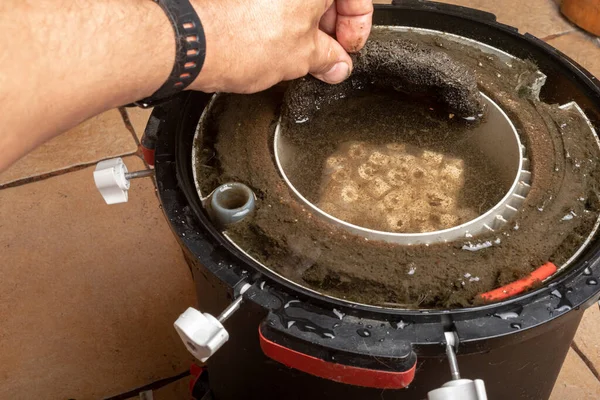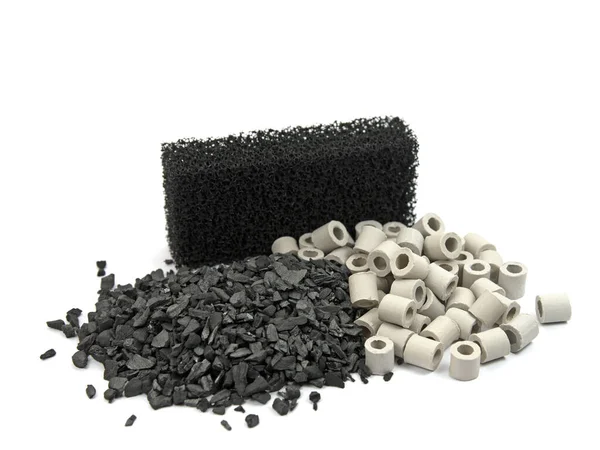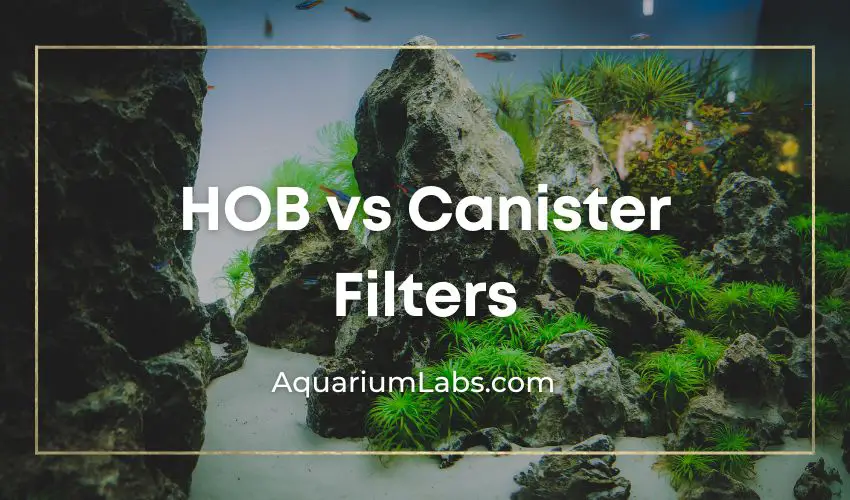When setting up a new tank, choosing a filter is one of the most important things you will do.
And the two most popular varieties are canister filters and hang-on-back (HOB) filters.
Both will provide clean water for an aquarium. But they offer advantages and drawbacks that may make one better or worse for you.
In this article, we will consider the many canister and HOB filter pros and cons in a balanced way to help you decide what’s best for your fish tank!
Why Is Choosing The Right Filter Important?

Different filtration system designs can serve different needs for fish owners. Since not every tank is the same, we need the right tool for a particular setup.
How Do Canister And HOB Filters Work?
When comparing a canister filter vs hob filters, there are quite a few similarities. Both kinds are designed to filter aquarium water using three tried and true strategies:
Mechanical Filtration
Mechanical filtration is the simplest way to filter water in an aquarium. It consists of using physical screens to catch any small particles that are suspended in the water. Some media options include cotton floss, felt fabric, sand, and diatomaceous earth.
The finer the screen, the smaller the particles the mechanical filter material can catch.
This video is an excellent breakdown of what aquarium filter carbon is and how it works to polish your tank water!
Chemical Filtration
Chemical filtration uses chemical reactions to change pollutants into harmless material.
Or they can bind free-floating molecules to the media itself. Activated charcoal is the most popular chemical filtration method.
It works by binding free-floating organic molecules to itself. But it needs to be swapped out every few weeks as it gets used up.
Biological Filtration
The last of the three ways to clean a tank’s water is arguably the most important. Biological filtration works when beneficial bacterial development is encouraged by the design of your aquarium filter.
Biological filtration is what breaks down the ammonia released as fish waste.
Ammonia also comes from the action of rot-causing bacteria as they feed on leftover food, fish poop, and other sources of organic matter.
Ammonia is very toxic to aquarium life (though it is a great plant fertilizer).
Fortunately, the beneficial bacteria found in an established (cycled) aquarium use this as food, converting it into the less toxic chemical nitrite. Unfortunately, nitrite is still not great for fish and invertebrates.
Fortunately, a second set of bacteria eat that, converting it into nitrate.
Nitrate then accumulates until you remove it via water changes. Plants can also use nitrate as fertilizer, but they prefer ammonia and nitrite and will suck those chemicals up first whenever they can.
There are many strategies to make this filtration model work. Bio wheels are commonly found on power filter designs like those made by Marineland Penguin.
However, you can use any material with a large enough surface area for bacteria to colonize. Canister filters often use ceramic media or lava rock to provide ample biological filtration for a tank.
Canister Filter VS HOB Filters: What Are the Main Differences?
The differences between a canister filter vs hob filters may not be obvious at first. After all, both sets of equipment do the same thing. Both power filters and canister filters
- Filter Media Chambers: Canister filters tend to have larger media chambers that are easier to customize. This makes them more versatile and effective in a wider range of circumstances
- Ease of Maintenance: A HOB power filter is much easier to both setup and maintain, both in terms of use as well as the time it takes to keep it running properly
- Price: Most HOB filter designs are cheaper than a canister filter rated for the same sized fish tank
| Canister Filter | Hang-On-Back Filter | |
|---|---|---|
| Setup and Maintenance | Medium to Difficult | Easy |
| Water Flow | High | Low to High |
| Customizable | High | Low to Medium |
| Price | High | Low to Medium |
What Are The Benefits Of A Canister Filter?
There are quite a few canister filter pros to consider when shopping for a primary filter! They are especially good for planted or saltwater aquarium systems, where crystal clear aquarium water is needed.
Canister filters offer the most customizable filtration experience in the aquarium hobby.
This is because the interior has loads of extra space for any kind of media you want to add. Water is forced through at high pressurization, so bypassing of the media rarely happens inside a canister filter unit.
Most aquarists prefer the tried and true duo of activated carbon and cotton floss. If these are your favorite media options, then a hang-on-back filter might be all you really need.
But a canister filter allows you to use more exotic options with ease. Lava rock and ceramic bio-rings are a great choice that don’t always fit inside hang-on-back filter chambers.
Ammonia-absorbing zeolite resin and phosphate removing media are also handy, especially for saltwater aquariums full of sensitive corals.
Canister filters also make it easier to install accessories like an inline heater vs hang-on-back filters, which usually have a short, hard outlet tube.
Some even have these accessories built-in already. You can even get a UV stabilizer to kill single-celled bacteria and algae that the lift tube picks up.
For medium-sized aquariums of 40-75 gallons, the Fluval 307 is a popular option. This canister filter includes rubberized components that ensure the unit runs ultra-quiet while processing tank water.
Are Canister Filters Better Than HOB Filters?
A canister filter is not better than a HOB power filter; it is simply a different way of purifying tank water.
It is true that a canister filter will hold more media and often has a more powerful pump compared to a HOB filter rated for the same fish tank.
But there are tradeoffs; a canister filter is almost always more expensive than an equivalent HOB filter. They also hold more filter media which means you have to spend more to fill them.
And filter maintenance can be more complicated since canister filters don’t usually have drop-in cartridges as many HOB filters do.

A media change can be done in 5 minutes with many HOB filter designs using a preconstructed bag of cotton and activated carbon.
But a canister filter requires you to seal the inlet tubes, remove the unit from under the tank, open it, and sort through several messy filter media chambers.
This difficulty means that HOB filters are a much better choice for beginning aquarists.
As well as for fish tanks where the inhabitants aren’t especially sensitive, such as most of the freshwater fish found in pet stores.
Do You Really Need a Canister Filter?
For saltwater aquarium keepers, a canister filter is usually a better choice.
Saltwater and reef aquariums have a much lower tolerance for elevated ammonia, nitrite, and nitrate levels.
Marine fish and corals will stress and die faster than freshwater fish tank inhabitants.
Canister filters have much larger compartments for filter media.
This, in turn, means you can provide more chemical filtration and biological filtration compared to most hob filters.
What Are The Benefits Of An HOB Filter?
At first glance, you might think power filters are inferior to canister filters.
After all, they have smaller media chambers and are less customizable.
Many also don’t turn over aquarium water nearly as effectively in a larger tank since the pumps are typically smaller.
But many of the best hob filter designs are ideal for small tanks and medium-sized tank setups.
Sometimes canister filtering systems are overkill for simple setups.
What if you are keeping hardy freshwater community fish species like guppies, barbs, corydoras, and other fish?
If so, then a canister filter really isn’t required for happy, healthy fish.
So long as the tank isn’t overstocked and you aren’t overfeeding, you may only see minimal water quality improvements by running a canister filter.
It’s when you need to track trace amounts of nitrate, phosphate, and other pollutants that a canister filter becomes the preferred model.
The price of most HOB filter designs compared to even a basic canister filter is also a solid benefit.
The AquaClear line of fish tank filters are favorites of ours due to their fine balance of effective water flow, filtration, and affordability!

Are HOB Filters Better Than Canister Filter?
A HOB filter is a good alternative to a canister filter. But in most cases, you are fine with either option.
If cost is not an issue, then I would choose a canister filter for setups larger than 55 gallons since they do a better job with larger volumes of water.
But for smaller aquarium sizes, a HOB filter will do a fine job.
A HOB filter is also an excellent secondary filter if you have large tanks with canister filters already running on them.
Maybe there is a dead zone on the opposite end of the aquarium where water isn’t getting properly turned over.

Or you’ve just upgraded to larger tanks but don’t want to throw out a canister filter that is working perfectly.
Adding a small HOB filter can help by adding some extra biological, chemical, and mechanical filtration capacity!
Wrapping Things Up
This heated debate does not have a clear conclusion since both will provide clean water for your tank. It really depends on what you need for your aquarium.
Both kinds of filters provide space for filter material. They also provide biological, mechanical, and chemical filtration.
But the main difference is that canister filters are much better at providing plenty of space for beneficial bacteria to colonize since their media chambers are so much larger.
They also make chemical filtration easier since you can add any media you prefer in larger amounts.
When comparing canister vs hang-on-back filters, the amount of water flow depends mostly on how powerful the unit’s pump is as well as whether you are maintaining a proper maintenance schedule.
If you are lax with maintenance, a hang-on-back tank filter is a better choice. These external filters are easier to maintain, often only taking 5 minutes for you to swap cartridges in and out.
A single HOB filter is more than enough for aquariums 40 gallons or less in volume. For 50-75 gallon aquariums, you should weigh the pros and cons of a canister filter vs hob filter since either one is a good choice.
For a larger tank, canister filters are usually the best choice, especially when keeping fish that produce loads of waste.
However, a HOB filter can provide extra filtration on top of a canister filter. Or even two HOB filters.
Related Reading:

